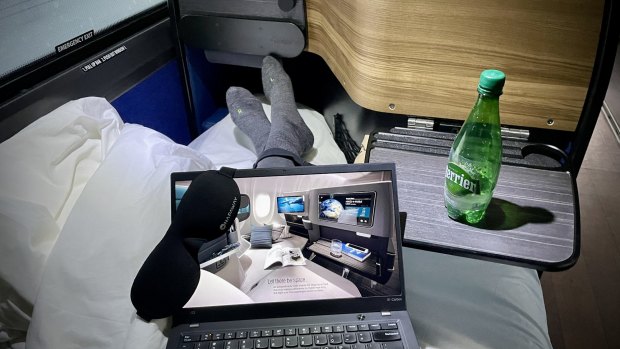This was published 1 year ago
Long distance bus travel in Australia: The daggiest way to travel is ripe for a comeback
By Lee Tulloch

Sleeper buses, like the Napaway, are increasingly popular in the US.
It's the daggiest way to travel long distance, but bus travel might be about to have a major image makeover.
Like many people, I've done my best over the years to avoid long distance bus travel in Australia. I have dim memories of middle of the night rest stops at brutally lit service stations, sitting for hours on end with a numb backside looking out at interminable, unspectacular views of a highway and struggling to get comfortable enough to sleep with a pillow jammed in a windowsill.
Sounds a bit like a long-haul economy flight, in fact.
But flights between our cities get us to our destinations in remarkably short times if there aren't cancellation and delays and they've been cheap enough in the past to be almost universally affordable, thanks to frequent discounts and deals.
A bus ride, Sydney to Melbourne, for instance, takes about 12 hours. I haven't done this route for decades and I'm sure the comfort of the buses has improved with the advent of onboard Wi-Fi and restrooms, but the distance remains the same.
Bus routes sometimes cover destinations that can't be conveniently reached by train or plane, but people mostly choose a bus on routes where there are alternative modes of transport because it's the cheap option.
I was curious about this. Taking a quick look, I could see that Greyhound's fares in November for Sydney-Melbourne overnight are $135 one way and $160 travelling on a fully flexible premium fare. Even though in the past you could get a cut-price airfare for this route for about the same price, there's the cost of getting to and from an airport like Tullamarine to consider. The comparable price on budget bus company Firefly was $95, regular fare.
One advantage of buses is that they depart from city centres, eliminating costly airport transfers. Lost luggage is less of an issue, as baggage handling happens under your supervision. There are no long security lines either.
Still, I have avoided long distance buses most of my life. Or should I say "coaches" as the industry likes to call buses that travel distances. (A bus is what you ride in the suburbs, a coach is what Trafalgar uses to transport you around Europe.)
Road safety was one issue for me. But I was surprised to find out that buses in general are four times safer than passenger rail travel and 50 times safer than travelling in a private car. The introduction of compulsory seatbelts and increased checks on driver documentation and hours have made a difference.
In terms of carbon footprint, Greyhound claims their coaches emit 55-77 per cent less CO2 than a plane for the same distance. If you took one of its buses rather than a private car, say on the Hume Highway, you'd reduce your carbon dioxide emissions by 85 per cent. That's primarily because you're sharing the journey's emissions with dozens of other people. Buses today are still fossil fuel operated vehicles.
Once buses and coaches are electrified, though, they'll become a significantly greener mode of transport. There is plenty of activity around this in every state, including the potential development of an electric bus manufacturing plant in Sydney. The Climate Council says seven out of 10 Australians are keen to see Australia's entire bus fleet electrified as soon as possible. Existing diesel buses can be converted to batteries in some cases, making the transition quicker.
With fast trains a long way off, and with airfares in the stratosphere, budget-friendly buses might be having a moment at a time when people are keen to get out and travel Australia but cost of living pressures have made them rethink how they're going to do it.
Buses still not sexy? I read a recent article in the New York Times about the growing popularity in North America of the luxury sleeper bus, introduced by companies such as Napaway and The Jet Bus. The sleeper buses provide seats that are more like those of business class on a low-cost airline, with memory foam mattresses, fake fur blankets and even seats that stretch out fully flat in some cases. It's not particularly luxe, but I'd take it for a 10-hour trip.
In the cinema, long distance bus rides, in movies such as Midnight Cowboy, Hud and It Happened One Night, don't just represent a cheap way to travel. They represent escape. And freedom.
While we're waiting for the train, maybe it's time to hitch a bus ride.
lee.tulloch@traveller.com.au
Sign up for the Traveller newsletter
The latest travel news, tips and inspiration delivered to your inbox. Sign up now.